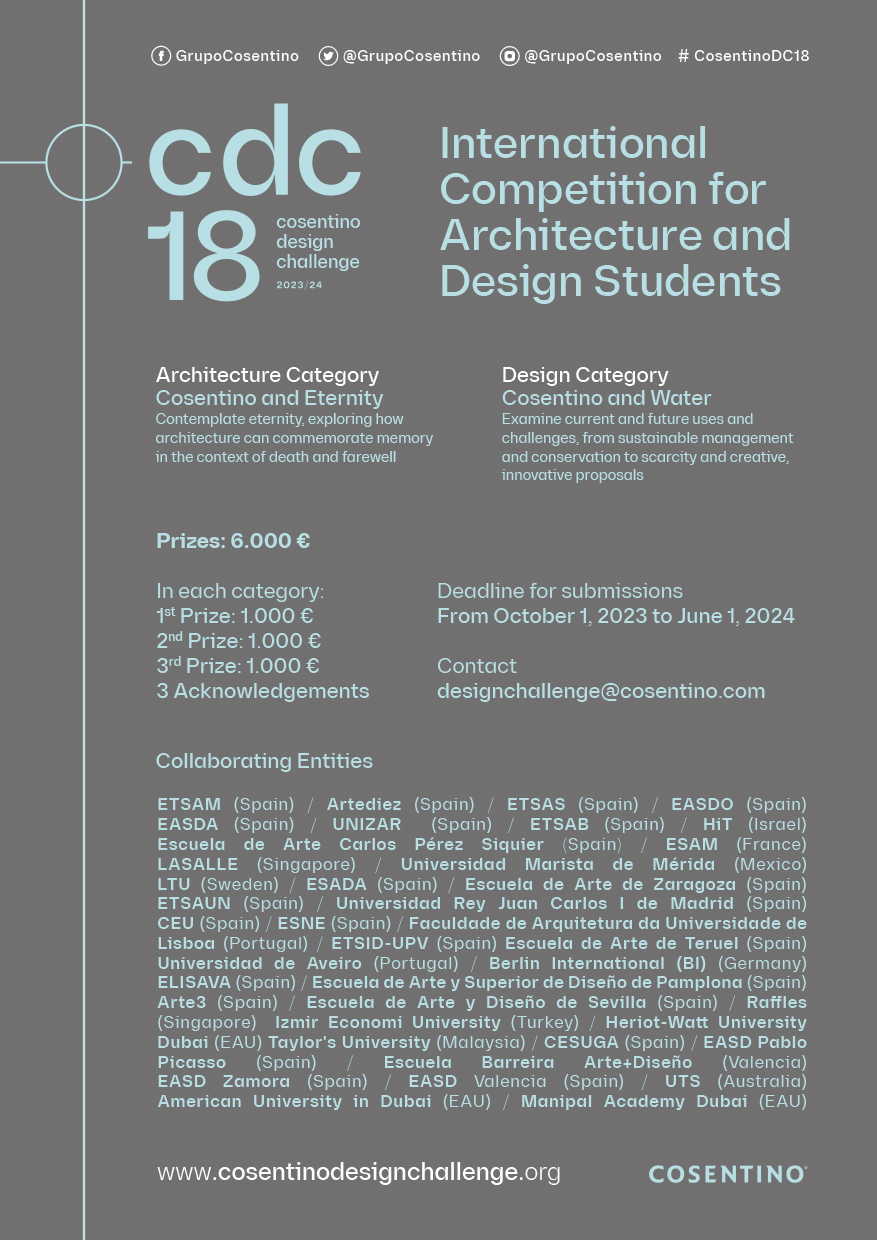Programme
Cosentino Design Challenge consists of two categories:
CDC International Design
The 18th Cosentino Design Challenge International Design Competition has the objective of:
“COSENTINO AND WATER”
Examine current and future uses and challenges, from sustainable management and conservation to scarcity and creative, innovative proposals
Students may choose the form and surface of the area of action freely.
Details of the programme and submission format are explained in more detail in the competition terms and conditions.
CDC International Architecture
The 18th Cosentino Design Challenge International Architecture Competition has the objective of working on:
“COSENTINO AND ETERNITY “
Contemplate eternity, exploring how architecture can commemorate memory in the context of death and farewell
Details of the programme and submission format are explained in more detail in the competition terms and conditions.
Timeline
No pre-inscription is required.
The competition is open for submissions at 9 a.m. on 1st of October 2023 and closes on 1st of June 2024 at 11.59 p.m.
Any queries regarding the terms and conditions of the competition should be sent any time between the 1st of October 2023 and the 1st of June 2024.
The presentation of prizes will take place at an official event whose date and location will be made known to finalists and partner schools or centers for higher education at an opportune time.
Prizes
For each category (CDC18 Architecture and CDC18 Design) the following prizes will be awarded: Three first prizes, three second prizes, and special mentions. These comprise a total of six first prizes and six second prizes plus as many special mentions as the jury sees fit to award.
Each of the six first prizes will consist of €1,000.
The awarding of special mentions will be at the discretion of the jury.
Winners and all candidates who receive special mentions will also be given a certificate stating the result of their participation in the competition.

Jury
The voting process will be composed of two phases: 1) on-line voting; and 2) face-to-face voting.
A first phase of On-line voting: This phase will consist of one representative teacher from each partner school. As a result of this voting process, there will be 20 finalist projects in the Architecture category and 20 finalist ones in the category of Design.
A second phase of Face-to-face voting process: This phase will consist of; 1 person of renowned prestige in the world of architecture, design, or professionals in the sector; 1 representative of the Cosentino Group; and 5 professors from partner schools. The five representatives will be selected by drawing lots witnessed by a public notary. The professors resulting from the draw, will not be able to enter the draw of the next edition. They will be back into the draw two years after their participation in the face-to-face jury session.
Each member of the jury will have say and a vote when judging the submitted projects. The secretary of the jury will have a say but no vote.
The jury’s decision cannot be appealed.
Confidentiality is guaranteed for all designs. The panel e-mails will be downloaded by a person neither say nor vote on the jury. E-mails containing personal information will only be opened once the jury has reached a decision and in order to verify the information of the winners and special mentions.
The jury’s decision will be launched live via social media and recorded in an official document that will be published 15 days after the decisive meeting is held. The jury’s deliberation will take place throughout the month of June 2024.
The presentation of prizes will take place at an official event whose date and location will be made known to finalists and participating educational centres.
The jury will examine the following criteria:
- The conceptual and technical quality of the project.
- The analytical study, thought process and research of the subject.
- The research on the spatial experience of the suroundings.
- The creativity of the design.
- The innovativeness of the design.
- The environmental respect of the design.
- The adaptation of the project idea to the expressive capacity of COSENTINO GROUP brand materials and products.
- New ideas for materials, finishes, applications, etc. that may arise.
- The feasbility for the development and construction of the projects presented.
- The adaptation of the chosen medium for the presentation with regards to graphics, expressivity and the kind of idea presented.
- The presentational quality of the design.
www.cosentino.com
